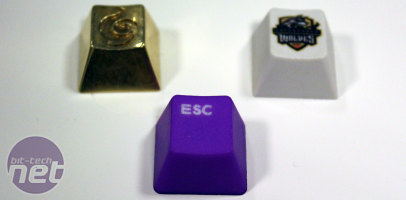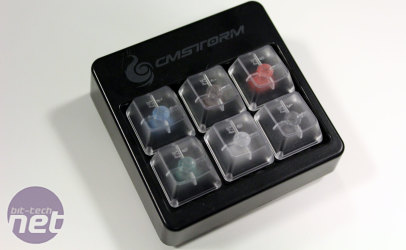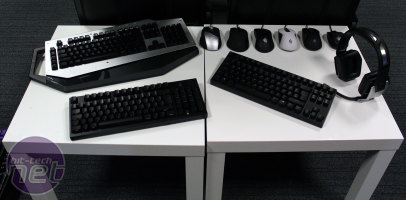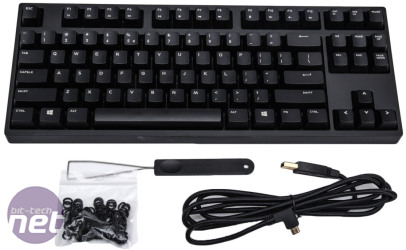
During my time at Cooler Master HQ, I sat down with various product managers, one of which, Bram Rongen, handles the gaming division CM Storm. His responsibilities extend to all peripherals and accessories, though some cases are also marketed under the brand.
Unfortunately, CM Storm has nothing new to announce at present. After all, it's had numerous launches in the past few months, including the Sirus-C, the Quick Fire Rapid-I, the Resonar and most recently the NovaTouch TKL. This latter one is the division's most important product for at least the rest of the year, as it is the new flagship keyboard (it even has its own microsite). Bram is rightfully very proud of the NovaTouch TKL – it's a fantastically crafted piece of kit.
Of course, no company will do too well without a strong product catalogue, but our conversation got me thinking about how there is now so much more beyond this for CM Storm and other such companies and brands when it comes to success in the world of gaming peripherals.
[break]
It may be a tired marketing phrase by now, but gaming is bigger than ever, with a massive part of that accounted for by competitive PC gaming through games like League of Legends, Dota 2, StarCraft II and CS:GO. Countries like South Korea may be leading the charge, but the growth is global, and it doesn't appear to be slowing down. Esports is now finding its way to national television, with many millions more watching via services like Twitch. We've even seen universities begin to offer scholarships to skilful players. Esports is big business, with competition prizes regularly reaching into the tens and hundreds of thousands of dollars or even more – a Chinese Dota 2 team took home a cool $5 million between them this year, almost double what Novak Djokovic received for winning Wimbledon.

Click to enlarge - Pro gamers are using in-ear headsets like the Resonar for sound, and aircraft-grade noise cancelling models on top to block out distracting cheers and screams
This all adds up to more people playing and watching games, and for businesses that means more people to sell things to; CM Storm itself has just enjoyed a second year of over 100 percent growth. Of course, gamers can get by with basic, functioning equipment, just as you can play football in knackered trainers and your dad's old gym shorts, but in both instances there's a wealth of high-end, specialist gear available. A keyboard, mouse and headset combination can easily cost upwards of £200, and people are ready and willing to splash the cash. For brands like CM Storm, getting people to first know your brand and second to believe in it is key.
So, what strategies are used to achieve this? Well, to start, you need a name, and one like Cooler Master makes little sense in gaming, hence CM Storm. Only in September we saw the launch of Corsair Gaming, perhaps a little uncreative but still a clear push for there to be a distinguishable gaming entity separate from the main. Asus has ROG and now Strix peripherals, and Kingston has HyperX. It's happening more and more and it shouldn't come as a surprise as companies look to achieve the sort of brand recognition enjoyed by Roccat and especially Razer, both of which are built entirely on the peripherals business.
Then there's sponsorship – Bram told me it's no longer as simple as putting a logo on the clothing of a few gamers, though this is of course still done. High profile teams, highly regarded players and even commentators are now being sponsored to effectively be the face of a brand. Sort of like ASRock has done with its Fatal1ty motherboards and marketing, only more... relevant. For its part, CM Storm has sponsorship deals now with at least 20 teams, as well as two StarCraft II players, Polt and Revival, both of whom have also been used for direct feedback on the development of a new CM Storm mouse set for Q1 2015 – it's very much a two way street.
There are myriad ways sponsorship is done as well. For the high profile players it's typically funding and equipment i.e. helping them get around the world to tournaments where they will then be exposed to massive audiences while wearing and using the gear – some teams like Copenhagen Wolves have even had custom keycaps made for them. But naturally CM Storm is always on the watch for new opportunities, sponsoring small university teams or YouTube personalities with hardware and tournament prizes, for example. After all, you never know how big somebody might end up getting.

Click to enlarge - Custom CM Storm keycaps; the top right one is for players in the Copenhagen Wolves team
Event presence is another way or drumming up interest. I'd heard Gamescom was big, but even so I couldn't believe quite how massive it really was when I attended earlier this year. As Bram told me, it's critical that attendees are exposed to the brand, but simply having a booth isn't everything. Like many, CM Storm takes the approach of letting people see that the people who work for the company are just as passionate about gaming as the fans rather than just corporate faces.

Click to enlarge - These can be used at events to quickly and easily show people the differences between mechanical switch types
Sadly, we couldn't draw CM Storm to disclose exact figures, but the amount spent on marketing, both at events and on players, is a “massive chunk” of the overall budget, and it's easy to believe.
One final thing I think is of interest is the approach of targeting younger audiences. Here at bit-tech, we tend to get wrapped up in expensive peripherals, from mechanical, backlit keyboards to feature touting mice and surround sound headsets. As I said before, such things aren't a necessity, but there's an entire generation of people playing games who for the most part can't afford such luxuries even if they wanted them.
One approach CM Storm is taking is to produce keyboard and mice bundles like Devastator and Octane that have a younger, “gamey” look that also don't cost the earth. That way, if a kid sees their favourite player using CM Storm and wants to follow suit, they aren't locked out and forced to turn elsewhere. For about £30 to £40 they can equip themselves for gaming, and if the design and performance hold up then it makes them a more likely customer in the future when they have a bit more cash to spare.
What do you think about the ways CM Storm and companies like it are responding to the massive growth in gaming and particularly esports, and how do you think the strategies will develop in the future? I'd be interested to hear your thoughts in the forums.
Unfortunately, CM Storm has nothing new to announce at present. After all, it's had numerous launches in the past few months, including the Sirus-C, the Quick Fire Rapid-I, the Resonar and most recently the NovaTouch TKL. This latter one is the division's most important product for at least the rest of the year, as it is the new flagship keyboard (it even has its own microsite). Bram is rightfully very proud of the NovaTouch TKL – it's a fantastically crafted piece of kit.
Of course, no company will do too well without a strong product catalogue, but our conversation got me thinking about how there is now so much more beyond this for CM Storm and other such companies and brands when it comes to success in the world of gaming peripherals.
[break]
It may be a tired marketing phrase by now, but gaming is bigger than ever, with a massive part of that accounted for by competitive PC gaming through games like League of Legends, Dota 2, StarCraft II and CS:GO. Countries like South Korea may be leading the charge, but the growth is global, and it doesn't appear to be slowing down. Esports is now finding its way to national television, with many millions more watching via services like Twitch. We've even seen universities begin to offer scholarships to skilful players. Esports is big business, with competition prizes regularly reaching into the tens and hundreds of thousands of dollars or even more – a Chinese Dota 2 team took home a cool $5 million between them this year, almost double what Novak Djokovic received for winning Wimbledon.

Click to enlarge - Pro gamers are using in-ear headsets like the Resonar for sound, and aircraft-grade noise cancelling models on top to block out distracting cheers and screams
This all adds up to more people playing and watching games, and for businesses that means more people to sell things to; CM Storm itself has just enjoyed a second year of over 100 percent growth. Of course, gamers can get by with basic, functioning equipment, just as you can play football in knackered trainers and your dad's old gym shorts, but in both instances there's a wealth of high-end, specialist gear available. A keyboard, mouse and headset combination can easily cost upwards of £200, and people are ready and willing to splash the cash. For brands like CM Storm, getting people to first know your brand and second to believe in it is key.
So, what strategies are used to achieve this? Well, to start, you need a name, and one like Cooler Master makes little sense in gaming, hence CM Storm. Only in September we saw the launch of Corsair Gaming, perhaps a little uncreative but still a clear push for there to be a distinguishable gaming entity separate from the main. Asus has ROG and now Strix peripherals, and Kingston has HyperX. It's happening more and more and it shouldn't come as a surprise as companies look to achieve the sort of brand recognition enjoyed by Roccat and especially Razer, both of which are built entirely on the peripherals business.
Then there's sponsorship – Bram told me it's no longer as simple as putting a logo on the clothing of a few gamers, though this is of course still done. High profile teams, highly regarded players and even commentators are now being sponsored to effectively be the face of a brand. Sort of like ASRock has done with its Fatal1ty motherboards and marketing, only more... relevant. For its part, CM Storm has sponsorship deals now with at least 20 teams, as well as two StarCraft II players, Polt and Revival, both of whom have also been used for direct feedback on the development of a new CM Storm mouse set for Q1 2015 – it's very much a two way street.
There are myriad ways sponsorship is done as well. For the high profile players it's typically funding and equipment i.e. helping them get around the world to tournaments where they will then be exposed to massive audiences while wearing and using the gear – some teams like Copenhagen Wolves have even had custom keycaps made for them. But naturally CM Storm is always on the watch for new opportunities, sponsoring small university teams or YouTube personalities with hardware and tournament prizes, for example. After all, you never know how big somebody might end up getting.

Click to enlarge - Custom CM Storm keycaps; the top right one is for players in the Copenhagen Wolves team
Event presence is another way or drumming up interest. I'd heard Gamescom was big, but even so I couldn't believe quite how massive it really was when I attended earlier this year. As Bram told me, it's critical that attendees are exposed to the brand, but simply having a booth isn't everything. Like many, CM Storm takes the approach of letting people see that the people who work for the company are just as passionate about gaming as the fans rather than just corporate faces.

Click to enlarge - These can be used at events to quickly and easily show people the differences between mechanical switch types
Sadly, we couldn't draw CM Storm to disclose exact figures, but the amount spent on marketing, both at events and on players, is a “massive chunk” of the overall budget, and it's easy to believe.
One final thing I think is of interest is the approach of targeting younger audiences. Here at bit-tech, we tend to get wrapped up in expensive peripherals, from mechanical, backlit keyboards to feature touting mice and surround sound headsets. As I said before, such things aren't a necessity, but there's an entire generation of people playing games who for the most part can't afford such luxuries even if they wanted them.
One approach CM Storm is taking is to produce keyboard and mice bundles like Devastator and Octane that have a younger, “gamey” look that also don't cost the earth. That way, if a kid sees their favourite player using CM Storm and wants to follow suit, they aren't locked out and forced to turn elsewhere. For about £30 to £40 they can equip themselves for gaming, and if the design and performance hold up then it makes them a more likely customer in the future when they have a bit more cash to spare.
What do you think about the ways CM Storm and companies like it are responding to the massive growth in gaming and particularly esports, and how do you think the strategies will develop in the future? I'd be interested to hear your thoughts in the forums.

MSI MPG Velox 100R Chassis Review
October 14 2021 | 15:04









Want to comment? Please log in.